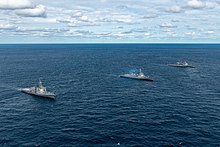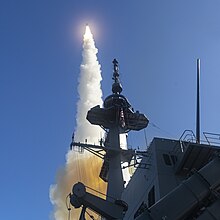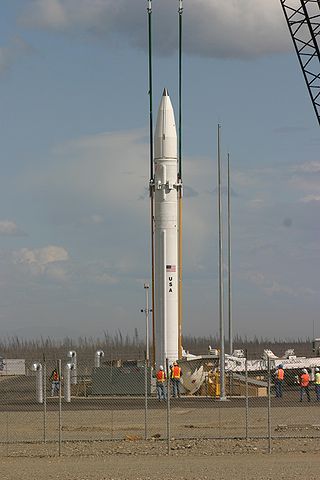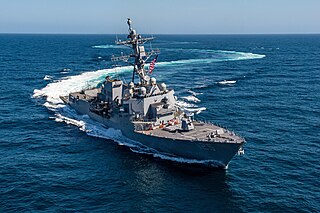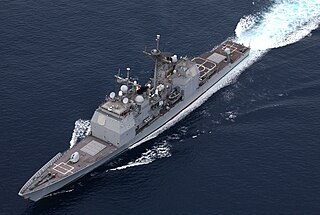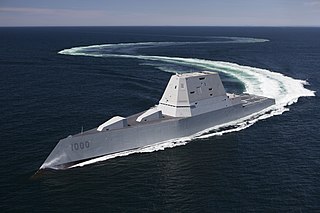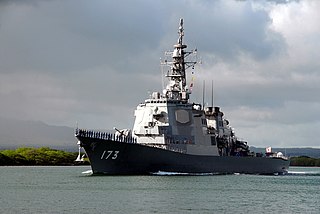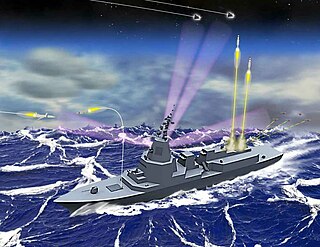| Name | Date | Result | Description [72] [73] [74] |
|---|
| CTV-1 | Sep 26, 1997 | Failure | The first flight test for the Navy Theater Wide program's Control Test Vehicle-1 (CTV-1) was on September 26, 1997, using a SM-2 Block IV missile modified for exo-atmospheric flight and launched from USS Russell. The missile self-destructed soon after launch after veering off course. The root cause of this problem was a defect in the Navy's existing SM-2 Block IV ordnance, not any guidance modifications for high-altitude flight. The Navy and BMDO thus characterized the flight as a "No-Test". |
| CTV-1A | Sep 24, 1999 | Success | The next flight for Raytheon's SM-3 came on September 24, 1999, during Control Test Vehicle (CTV)-1A (Codename: Stellar Phoenix). CTV-1a was a test of the first and second stage of the SM-3. The mission was considered a success. USS Shiloh was the launching ship. |
| FTR-1 | Jul 8, 2000 | Failure | The next mission was conducted in July 2000 and designated Flight Test Round (FTR-1) (Codename: Stellar Archer). This mission ended in failure when the Third Stage Rocket Motor (TSRM) failed to separate from the second stage. USS Shiloh was the launching ship. |
| FTR-1A | Jan 25, 2001 | Success | FTR-1a (Codename: Stellar Gemini) was conducted on January 25, 2001. This mission would be the first time a live unitary target was engaged by the Aegis BMD system. The test target was launched from the U.S. Navy's Pacific Missile Range Facility located on the Hawaiian island of Kauai. FTR-1a would demonstrate exo-atmospheric avionics operation of the SM-3 Kinetic Warhead (KW) and the real-time performance of the Aegis BMD AN/SPY-1 radar. At the time this test was conducted, the KW's propulsion system, the Solid Divert and Attitude Control System (SDACS), was still being developed. Total system operation was demonstrated in FM-2. The mission was considered successful when the KW acquired and tracked the test target for several seconds. USS Lake Erie was the launching ship. |
| FM-2 | Jan 25, 2002 | Success | The purpose of Flight Mission (FM)-2 (codename: Stellar Eagle) was to characterize the Aegis Weapon System and Standard Missile 3 interceptor. The mission was not required to intercept the target. On January 25, 2002, an SM-3 launched from USS Lake Erie collided with a test target northeast of the island of Kauai. This mission was the first interception of a ballistic missile from a sea-based platform. |
| FM-3 | Jun 13, 2002 | Success | Aegis BMD succeeded in intercepting a unitary target missiles launched from PMRF during FM-3 (Codename: Stellar Impact). USS Lake Erie was the firing ship. This mission marked the successful completion of the Aegis LEAP Intercept program. June 13, 2002 was also the date that the United States withdrew from the Anti-Ballistic Missile Treaty (ABM Treaty), which limited the development of a strategic anti-ballistic missile system (to be considered strategic Aegis would need capability against the current Russian ICBMs and SLBMs). |
| FM-4 | Nov 21, 2001 | Success | Aegis BMD intercepted a unitary ballistic missile during FM-4 (codename: Stellar Viper). FM-4 was the first Aegis BMD test to conduct the "aimpoint shift" maneuver. The aimpoint shift increases the probability that the ballistic missile ordnance will be destroyed at intercept. USS Lake Erie was the launching ship. |
| FM-5 | Jun 18, 2003 | Failure | On June 18, 2003, the FM-5 mission (codename: Stellar Hammer) resulted in the first test failure of an operational Aegis BMD system. During the test, the SDACS propulsion system used to guide the SM-3's kinetic warhead suffered a malfunction after ignition. It is important to note that prior to the rocket motor failure the SM-3 kinetic warhead was on an intercept course with the test target. USS Lake Erie was the firing ship. |
| FM-6 | Dec 11, 2003 | Success | The next mission, Codename: Stellar Defender, implemented a modification to the SDACS design so as not to endanger the warhead's ability to intercept. This override allowed the KW to navigate with reduced (but no less lethal) capability. FM-6 once again featured a successful interception. USS Lake Erie was the firing ship. |
| FTM-04-1 | Feb 24, 2005 | Success | After the FM-6 mission, the Missile Defense Agency implemented a change to the flight test naming convention for all subsequent ABMD flight tests. According to MDA the new convention better reflected the program's position within the Block 2004/2006 schema of development. The new name, Flight Test Mission (FTM) 04-1 (codename: Stellar Dragon), indicated that this would be the first flight test under the Block 2004 development cycle for Aegis BMD. The flight test demonstrated yet again the system's ability to destroy an enemy ballistic missile. USS Lake Erie was the firing ship. |
| FTM-04-2 | Nov 17, 2005 | Success | Codename Stellar Valkyrie, this was the first mission to utilize a target missile with a separating warhead. This new target missile, termed a Medium Range Target (MRT) more closely resembled real world threat missiles, but the SM-3 Block I missile was not fooled and intercepted the warhead to score the sixth interception for the program out of seven tries on November 17, 2005. USS Lake Erie was the firing ship. |
| FTM-10 | Jun 23, 2006 | Success | The FTM-10 test target was the MRT with a separating warhead. USS Shiloh was the launching ship and utilized the Aegis Weapon System version 3.6 for the first time. This test was the first to feature the latest model of the SM-3, the Block Ia. The mission was considered a success when the KW tracked, selected and intercepted the MRT reentry vehicle (RV). FTM-10 marked the first time another country participated in a sea-based anti-ballistic missile exercise. The Japanese government was interested in purchasing a system similar to Aegis BMD to deter potential threats and was invited to participate in the FTM-10 exercise. The Japanese naval vessel JDS Kirishima (a Kongō-class destroyer) was stationed off the coast of PMRF and observed all FTM-10 events. [75] |
| FTM-11 | Dec 7, 2006 | Failure | The Aegis Weapon System failed to engage the test target and never launched the interceptor. The cause of the failure, an on-board error, was discovered and corrected prior to the retest of FTM-11 test flight. USS Lake Erie was the firing ship. [76] |
| FTM-11 Event 4 | Apr 26, 2007 | Success | Aegis BMD successfully intercepted its eighth target in ten attempts. This test marked the 27th successful "Hit-to-Kill" intercept (for all MDA systems) since 2001. USS Lake Erie was the launching ship and utilized the Aegis 3.6 Weapon System. The interceptor was the SM-3 Block-Ia. This test not only demonstrated the ability of ABMD to intercept a ballistic missile but also demonstrated Lake Erie's ability to simultaneously track and intercept antiship missiles. This test also utilized the Solid Divert and Attitude Control System (SDACS), in the full pulse configuration. [77] |
| FTM-11A | Aug 31, 2007 | Success | Classified flight test. [78] |
| FTM-12 | Jun 22, 2007 | Success | USS Decatur, using the operationally certified Aegis Ballistic Missile Defense Weapon System (BMD 3.6) and the Standard Missile 3 (SM-3) Block IA missile, successfully performed a "hit to kill" intercept of a separating, medium range, ballistic missile. The target missile was launched from the Pacific Missile Range Facility on Kauai, Hawaii. The Ticonderoga-class cruiser USS Port Royal, Spain's Álvaro de Bazán-class frigate Méndez Núñez, and MDA's Terminal High Altitude Area Defense (THAAD) mobile ground-based radar also participated in the flight test. FTM-12 (Codename: Stellar Athena) was the first to use an Arleigh Burke-class destroyer as the launching ship. [79] |
| FTM-13 | Nov 6, 2007 | Success | USS Lake Erie launched two interceptors off the island of Kauai, Hawaii, engaging two short-range ballistic missile targets almost simultaneously. |
| FTM-14 | Jun 6, 2008 | Success | USS Lake Erie successfully intercepted a terminal phase target with a modified SM-2 Block IV interceptor. The aim of this mission was to test the interception and destruction of a short range ballistic missile target launched from a mobile launch platform. [80] |
| FTM-15 | Apr 15, 2011 | Success | The Missile Defense Agency (MDA), USS O'Kane, and the 94th Army Air and Missile Defense Command operating from the 613th Air and Space Operations Center at Hickam Air Force Base, Hawaii, successfully conducted a flight test of the Aegis Ballistic Missile Defense (BMD) element of the nation's Ballistic Missile Defense System, resulting in the intercept of a separating ballistic missile target over the Pacific Ocean. FTM-15, was the most challenging test to date, as it was the first Aegis BMD version 3.6.1 intercept against an intermediate-range target (range 1,864 to 3,418 miles) and the first Aegis BMD 3.6.1 engagement relying on remote tracking data. The ability to use remote radar data to engage a threat ballistic missile greatly increases the battle space and defended area of the SM-3 missile. [81] |
| FTM-16 Event 1 | Mar 15, 2011 | Success | USS Lake Erie successfully tracked a ballistic missile target. In addition to the BMD mission, Lake Erie also validated the ship's anti-air warfare (AAW) capability by destroying an incoming anti-ship cruise missile target with an SM-2 Block III missile in a live firing exercise. This was the first event in which a ship used BMD 4.0.1 Weapon System to engage an AAW threat. [82] |
| FTM-16 Event 2 | Sep 1, 2011 | Failure | A short-range ballistic missile target was launched from the U.S. Navy's Pacific Missile Range Facility on Kauai, Hawaii. Approximately 90 seconds later, a Standard Missile 3 (SM-3) Block 1B interceptor missile was launched from USS Lake Erie but an intercept of the target was not achieved. The failure was due to a third-stage rocket motor pulse failure [71] [83] |
| FTM-16 Event 2A | May 9, 2012 | Success | USS Lake Erie successfully conducted a flight test of the Aegis Ballistic Missile Defense (BMD) system, resulting in the first intercept of a short-range ballistic missile target over the Pacific Ocean by the Navy's newest Missile Defense interceptor, the Standard Missile 3 (SM-3) Block IB. [84] |
| FTM-17 | Jul 30, 2009 | Success | USS Hopper, detected, tracked, fired and guided a Standard Missile 3 (SM-3) Block (Blk) IA to intercept a sub-scale short range ballistic missile. [71] [85] |
| FTM-18 | Jun 27, 2012 | Success | USS Lake Erie successfully conducted a flight test of the Aegis Ballistic Missile Defense (BMD) system, resulting in the intercept of a separating ballistic missile target over the Pacific Ocean by the Navy's newest missile defense interceptor missile, the Standard Missile 3 (SM-3) Block IB. The test event was the second consecutive successful intercept test of the SM-3 Block IB missile and the second-generation Aegis BMD 4.0.1 weapon system. The first successful SM-3 Block IB intercept occurred on May 9, 2012. [86] [87] |
| FTM-19 | May 16, 2013 | Success | USS Lake Erie successfully conducted a flight test today of the Aegis Ballistic Missile Defense (BMD) system, resulting in the intercept of a separating ballistic missile target over the Pacific Ocean by the Aegis BMD 4.0 Weapon System and a Standard Missile 3 (SM-3) Block IB missile. This test exercised the latest version of the second-generation Aegis BMD Weapon System and Standard Missile, providing capability for engagement of longer-range and more sophisticated ballistic missiles. [88] |
| FTM-20 | Feb 13, 2013 | Success | USS Lake Erie successfully conducted a flight test of the Aegis Ballistic Missile Defense (BMD) system, resulting in the intercept of a medium-range ballistic missile target over the Pacific Ocean by a Standard Missile 3 (SM-3) Block IA guided missile. The in-orbit Space Tracking and Surveillance System-Demonstrators (STSS-D) detected and tracked the target, and forwarded track data to USS Lake Erie. The ship, equipped with the second-generation Aegis BMD weapon system, used Launch on Remote doctrine to engage the target. This event, designated Flight Test Standard Missile 20 (FTM-20), was a demonstration of the ability of space-based assets to provide mid-course fire control quality data to an Aegis BMD ship, extending the battlespace, providing the ability for longer range intercepts and defense of larger areas. [89] |
| FTO-1 | Sep 10, 2013 | Success | FTO-01 was conducted in the vicinity of the U.S. Army Kwajalein Atoll Ronald Reagan Ballistic Missile Defense Test Site and surrounding areas in the western Pacific. The test stressed the ability of the Aegis Ballistic Missile Defense (BMD) and Terminal High Altitude Area Defense (THAAD) weapon systems to function in a layered defense architecture and defeat a raid of two near-simultaneous ballistic missile targets. USS Decatur with its Aegis Weapon System detected and tracked the first target with its onboard AN/SPY-1 radar. The Aegis BMD weapon system developed a fire control solution, launched a Standard Missile 3 (SM-3) Block IA missile, and successfully intercepted the target. [90] In a demonstration of BMDS layered defense capabilities, a second AN/TPY-2 radar in Terminal Mode, located with the THAAD weapon system, acquired and tracked the target missiles. THAAD developed a fire control solution, launched a THAAD interceptor missile, and successfully intercepted the second medium-range ballistic missile target. THAAD was operated by soldiers from the Alpha Battery, 2nd Air Defense Artillery Regiment. As a planned demonstration of THAAD's layered defense capabilities, a second THAAD interceptor was launched at the target destroyed by Aegis as a contingency in the event the SM-3 did not achieve an intercept. [90] |
| FTM-21 | Sep 18, 2013 | Success | USS Lake Erie successfully conducted a flight test today of the Aegis Ballistic Missile Defense (BMD) system, resulting in the intercept of a complex separating short-range ballistic missile target over the Pacific Ocean by the Aegis BMD 4.0 Weapon System and a Standard Missile 3 (SM-3) Block IB guided missile. This was an operationally realistic test, in which the target's launch time and bearing are not known in advance, and the target complex was the most difficult target engaged to date. [91] |
| FTM-22 | Oct 3, 2013 | Success | USS Lake Erie successfully conducted an operational flight test of the Aegis Ballistic Missile Defense (BMD) system, resulting in the intercept of a medium-range ballistic missile target over the Pacific Ocean by the Aegis BMD 4.0 Weapon System and a Standard Missile 3 (SM-3) Block IB guided missile. FTM-22 is the 28th successful intercept in 34 flight test attempts for the Aegis BMD program since flight testing began in 2002. Across all Ballistic Missile Defense System programs, this is the 64th successful hit-to-kill intercept in 80 flight test attempts since 2001. |
| FTM-31 E1a | Mar 30, 2023 | Success | The USS Daniel Inouye (DDG 118) successfully executed Test FTM-31 E1a. The test highlights adjustments made after FTM-31 E1 (May 2021) which did not meet all its objectives; this test validates that the upgraded Standard Missile 6 (SM-6) Dual II SWUP capability is now ready for use by the warfighter. [92] |
| Stellar Daggers | Mar 26, 2009 | Success | USS Benfold simultaneously engaged an SRBM in terminal phase and a cruise missile using SM-2s. [93] |
| JFTM-1 | Dec 18, 2007 | Success | The JFTM-1 test event verified the new engagement capability of the Aegis BMD configuration of the recently upgraded Japanese destroyer, JS Kongō. At approximately 12:05 pm (HST), 7:05 am Tokyo time on December 18, 2007, a ballistic missile target was launched from the Pacific Missile Range Facility, Barking Sands, Kauai, Hawaii. JS Kongō crew members detected and tracked the target. The Aegis Weapon System then developed a fire control solution and at approximately 12:08 pm (HST), 7:08 am Tokyo time, a Standard Missile 3 (SM-3) Block IA was launched. Approximately three minutes later, the SM-3 successfully intercepted the target approximately 100 miles above the Pacific Ocean. [94] |
| JFTM-2 | Nov 19, 2008 | Failure | JFTM-2 was a test of the newest engagement capability of the Aegis Ballistic Missile Defense configuration of the recently upgraded Japanese destroyer, JS Chōkai. At approximately 4:21 pm (HST), 11:21 am (Tokyo time) a ballistic missile target was launched from the Pacific Missile Range Facility, Barking Sands, Kauai, Hawaii. JS Chōkai crew members detected and tracked the target using an advanced on-board radar. The Aegis Weapon System then developed a fire control solution, and at approximately 4:24 pm (HST), 11:24 am (Tokyo time) on Nov 20, a single Standard Missile 3 (SM-3) Block IA was launched. Approximately two minutes later, the SM-3 failed to intercept the target. The cause of the failure was an SM-3 Block IA interceptor divert and attitude control malfunction. [71] [95] |
| JFTM-3 | Nov 19, 2008 | Success | The JFTM-3 test event verified the newest engagement capability of the Japan Aegis BMD configuration of the recently upgraded Japanese destroyer, JS Myōkō. At approximately 6:00pm (HST), 1:00 pm Tokyo time on October 28, a separating, medium-range ballistic missile target was launched from the Pacific Missile Range Facility, Barking Sands, Kauai, Hawaii. JS Myōkō crew members detected and tracked the target. The Aegis Weapon System then developed a fire control solution and, at approximately 6:04pm (HST), 1:04 pm Tokyo time a Standard Missile 3 (SM-3) Block IA interceptor missile was launched. Approximately three minutes later, the SM-3 successfully intercepted the target approximately 100 miles above the Pacific Ocean. [96] |
| JFTM-4 | Oct 28, 2010 | Success | The JFTM-4 test event verified the newest engagement capability of the Japan Aegis BMD configuration of the recently upgraded Japanese destroyer, JS Krishima. At approximately 5:06 p.m. (HST), 12:06 p.m. Tokyo time on October 29, 2010, a separating 1,000 km class ballistic missile target was launched from the Pacific Missile Range Facility at Barking Sands, Kauai, Hawaii. JS Kirishima crew members detected and tracked the target. The Aegis Weapon System then developed a fire control solution and launched a Standard Missile 3 (SM-3) Block IA missile. Approximately three minutes later, the SM-3 successfully intercepted the target approximately 100 miles above the Pacific Ocean. [97] |
| FTI-01 | Oct 25, 2012 | Failure | The live-fire demonstration, conducted at U.S. Army Kwajalein Atoll/Reagan Test Site, Hickam AFB, and surrounding areas in the western Pacific, stressed the performance of the Aegis Ballistic Missile Defense (BMD), THAAD, and PATRIOT (PAC-3) weapon systems. USS Fitzgerald successfully engaged a low flying cruise missile over water. The Aegis system also tracked and launched an SM-3 Block 1A interceptor against a Short-Range Ballistic Missile. However, despite indication of a nominal flight of the SM-3 Block 1A interceptor, there was no indication of an intercept of the SRBM. The failure was attributed to an Inertial Measurement Unit failure. [71] [98] |
| Pacific BlitZ | Nov 1, 2008 | Mixed | Pacific Blitz was the first U.S. Navy proficiency firing to employ the SM-3 missile against a ballistic missile target. During the Fleet Exercise "Pacific Blitz", two Pearl Harbor-based Aegis BMD destroyers, USS Paul Hamilton and USS Hopper fired SM-3 missiles at separate targets. Upon detecting and tracking the target, USS Paul Hamilton launched an SM-3 missile resulting in a direct hit. USS Hopper successfully detected, monitored and fired at the second target, but the interceptor missed. The cause of the failure was attributed to an infrared seeker failure [71] [99] [100] |
| Pacific Phoenix | May 6, 2006 | Success | USS Lake Erie successfully intercepted a Unitary short-range target. [71] [78] |
| FTM-25 | Nov 6, 2014 | Success | USS John Paul Jones successfully conducted a flight test of the Aegis Ballistic Missile Defense (BMD) system, resulting in three successful near-simultaneous target engagements over the Pacific Ocean. One short-range ballistic missile target was intercepted by a Standard Missile 3 (SM-3) Block IB guided missile, while two low-flying cruise missile targets were engaged by Standard Missile 2 (SM-2) Block IIIA guided missiles near-simultaneously. |
| MMW event 1 | July 28, 2015 | Success | A short-range ballistic missile (SRBM) target was launched from PMRF in a northwesterly trajectory. USS John Paul Jones, positioned west of Hawaii, detected, tracked, and launched a SM-6 Dual I missile, resulting in a successful target intercept in the terminal stage. |
| MMW event 2 | July 29, 2015 | Success | A short-range ballistic missile (SRBM) target was launched from PMRF in a northwesterly trajectory. USS John Paul Jones, positioned west of Hawaii, detected, tracked, and launched a SM-2 block 4 missile, resulting in a successful target intercept. |
| MTMD | October 20, 2015 | Success | A Terrier-Orion short-range ballistic missile (SRBM) target was launched from the UK's Hebrides Range, northwest of Scotland. With multinational vessels in the North Atlantic participating in Maritime Theater Missile Defense, USS Ross launched a SM-3 Block IA missile, resulting in a successful target intercept. |
| FTO-02 event 2a | October 31, 2015 | Failure | The test stressed the ability of Aegis Ballistic Missile Defense (BMD) and Terminal High Altitude Area Defense (THAAD) weapon systems to negate two ballistic missile threats while Aegis BMD simultaneously conducted an anti-air warfare operation. A Short Range Air Launch Target (SRALT) was launched by a U.S. Air Force C-17. THAAD successfully intercepted the SRALT target. While THAAD was engaging the SRALT, an extended Medium Range Ballistic Missile (eMRBM) was air-launched by another Air Force C-17. The eMRBM target was detected and tracked by multiple BMDS assets including the AN/TPY-2 in forward-based mode, and USS John Paul Jones with its AN/SPY-1 radar. Shortly after eMRBM launch, a BQM-74E air-breathing target was also launched and tracked by USS John Paul Jones. Both Aegis BMD and THAAD launched interceptors to engage the eMRBM. USS John Paul Jones successfully launched a Standard Missile-3 (SM-3) Block IB Threat Upgrade guided missile, but an anomaly early in its flight prevented a midcourse intercept. However, the THAAD interceptor, in its terminal defense role, acquired and successfully intercepted the target. Concurrently, Aegis BMD successfully engaged the BQM-74E air-breathing target with a Standard Missile-2 Block IIIA guided missile. A failure review is currently underway to investigate the SM-3 anomaly. |
| FTO-02 event 1a | December 9, 2015 | Success | During the test, a target representing a medium-range ballistic missile was air-launched from a U.S. Air Force C-17 aircraft over the broad ocean area southwest of Hawaii. The Aegis Ashore Weapon System then launched the SM-3 Block IB Threat Upgrade guided missile from its Vertical Launch System. The SM-3's kinetic warhead acquired the target reentry vehicle, diverted into its path, and destroyed the target using the kinetic force of a direct impact. |
| FTM-27 | December 14, 2016 | Success | USS John Paul Jones, an Aegis baseline 9.C1 equipped destroyer, successfully fired a salvo of two SM-6 Dual I missiles against a complex medium-range ballistic missile target, demonstrating the Sea Based Terminal endo-atmospheric defensive capability. [101] |
| SFTM-01 | February 3, 2017 | Success | The test from USS John Paul Jones was the first launch of an SM-3 Block IIA missile from an Aegis Ballistic Missile Defense (BMD) ship, and the first intercept engagement using the Aegis Baseline 9.C2 (BMD 5.1) weapon system. SFTM-01 was the third flight test of the SM-3 Block IIA missile, but the first intercept attempt. [102] |
| SFTM-02 | June 21, 2017 | Failure | A medium-range ballistic target missile was launched from the Pacific Missile Range Facility at Kauai, Hawaii. The USS John Paul Jones (DDG-53) detected and tracked the target missile with its onboard AN/SPY-1 radar using the Aegis Baseline 9.C2 weapon system. Upon acquiring and tracking the target, the ship launched an SM-3 Block IIA guided missile, but the missile did not intercept the target. [103] The attempt was unsuccessful because a sailor on board the firing ship inadvertently designated the target as friendly, causing the Aegis Weapon System to break the engagement and initiate a message commanding the SM-3 Block IIA missile to destruct, destroying the missile in flight [16] |
| FTM-27 E2 | August 29, 2017 | Success | The USS John Paul Jones (DDG-53) successfully conducted a complex missile defense flight test, resulting in the intercept of a medium-range ballistic missile (MRBM) target using Standard Missile-6 (SM-6) guided missiles during a test off the coast of Hawaii. [104] |
| FS-17 E4 | October 15, 2017 | Success | The guided-missile destroyer USS Donald Cook (DDG-75) successfully detected, tracked and intercepted a medium-range ballistic missile target with a Standard Missile-3 Block IB guided missile. [105] |
| FTM-29 | January 31, 2018 | Failure | The Missile Defense Agency and U.S. Navy sailors manning the Aegis Ashore Missile Defense Test Complex (AAMDTC) conducted a live-fire missile flight test Jan. 31 using a Standard-Missile (SM)-3 Block IIA missile launched from the Pacific Missile Range Facility, Kauai, Hawaii. This was a developmental and operational test of a new capability and utilized a missile variant not yet in production. The primary objective of the test, to intercept an air-launched intermediate-range ballistic missile target with an SM-3 Block IIA missile, was not achieved. [106] |
| JFTM-5 Event 2 | September 11, 2018 | Success | The test event verified the newest BMD engagement capability of the Japan (J6) Aegis BMD configuration of the recently upgraded Japan destroyer, JS ATAGO (DDG-177). At approximately 10:37pm HST on September 11, 2018, a simple separating, ballistic missile target was launched from the Pacific Missile Range Facility at Barking Sands, Kauai, Hawaii. JS ATAGO crew members detected and tracked the target. The Aegis Weapon System then developed a fire control solution and a Standard Missile -3 Block IB Threat Upgrade (SM-3 Blk IB TU) missile was launched. The SM-3 successfully intercepted the target above the Pacific Ocean. [107] |
| FTM-45 | October 26, 2018 | Success | The USS John Finn (DDG-113) successfully conducted an intercept of a medium-range ballistic missile target with a Standard Missile-3 (SM-3) Block IIA missile during a flight test off the west coast of Hawaii. [108] |
| FTI-03 | December 10, 2018 | Success | The Aegis Ashore Missile Defense Test Complex (AAMDTC) at the Pacific Missile Range Facility (PMRF) at Kauai, Hawaii, successfully conducted Flight Test Integrated-03 (FTI-03). This was an operational live fire test demonstrating the Aegis Weapon System Engage On Remote capability to track and intercept an Intermediate Range Ballistic Missile (IRBM) target with an Aegis Ashore-launched Standard Missile-3 (SM-3) Block IIA interceptor. [109] |
| FTM-44 | November 17, 2020 | Success | At approximately 7:50 p.m. Hawaii Standard Time, (12:50 a.m., Nov. 17, Eastern Standard Time), the ICBM-representative target was launched from the Ronald Reagan Ballistic Missile Defense Test Site, located on Kwajalein Atoll in the Republic of the Marshall Islands, toward the broad ocean area northeast of Hawaii. In this developmental test, the USS John Finn (DDG-113) used engage-on-remote capabilities through the Command and Control Battle Management Communications (C2BMC) network as part of a defense of Hawaii scenario. After receiving tracking data from the C2BMC system, the destroyer launched a SM-3 Block IIA guided missile which destroyed the target. [110] |
| FTM-48 | October 25, 2023 | Success | Codename: Vigilant Wyvern. USS Carl M. Levin successfully conducted an interception of two Terrier Oriole medium-range ballistic missile targets with two SM-3 Block IA missiles and of two BQM-117A subsonic anti-ship cruise missile drone targets with four SM-2 Block IIIA missiles. The targets were launched from Pacific Missile Range Facility in Hawaii. [111] |
| FTX-23 | February 8, 2024 | Success | Codename: Stellar Sisyphus. The first part of the test was planned as a tracking event of a complex target with the primary objective of collecting data on the target scene from multiple sensors across different viewing angles. It involved USS McCampbell and USS Jack H. Lucas, together with the Aegis Ashore Missile Defense Test Complex and the Advanced Radar Development Evaluation Laboratory, tracking a Medium Range Ballistic Missile with countermeasures released by a Boeing C-17 Globemaster III plane flying over the Pacific Missile Range Facility in Hawaii. The second part of the test consisted in the successful interception of the target with a SM-3 Block IIA missile launched by USS McCampbell. [112] |
| FTM-32 | March 28, 2024 | Success | Codename: Stellar Laelaps. The test demonstrated the capability to detect, track, engage, and intercept an MRBM target in the terminal phase of flight. A Medium Range Ballistic Missile launched from the Pacific Missile Range Facility in Hawaii was intercepted through two SM-6 Dual II missiles launched by USS Preble. Support was provided also by USS Jack H. Lucas, as well as by the Australian Defence Force through HMAS Stuart and a Boeing E-7 Wedgetail aircraft. [113] |






